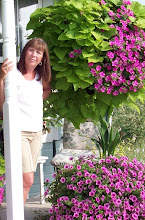 Sunshine & Snow I can't imagine a cottage garden---or any other garden for that matter---without the presence of German bearded iris. I remember when I first fell in love with these rhizomatous perennials. A few blocks from my childhood home lived a woman who tended an extremely large iris kingdom. I don't think she had need of a lawn mower because the iris had taken over every patch of ground but what the house sat upon. In May, her yard was a riotous canvas of brilliant color. Now, all these years later, I can't imagine just how many different varieties her garden had held. That was in the '70's
Sunshine & Snow I can't imagine a cottage garden---or any other garden for that matter---without the presence of German bearded iris. I remember when I first fell in love with these rhizomatous perennials. A few blocks from my childhood home lived a woman who tended an extremely large iris kingdom. I don't think she had need of a lawn mower because the iris had taken over every patch of ground but what the house sat upon. In May, her yard was a riotous canvas of brilliant color. Now, all these years later, I can't imagine just how many different varieties her garden had held. That was in the '70's Clarence
Clarence  Magical Encounter
Magical EncounterTurn the dial forward a few decades to 2001. The first house David and I bought after moving to the Kansas City area was one which had been owned previously by a gardener. Our first spring came with lots of surprises as we watched perennials emerge in all the different beds around the house, but the most spectacular were the iris. The second spring, I noticed they didn't flower nearly as profusely. The clumps of foliage were jam packed together in spots and bare in others among the bed. I decided it was time for reorder and after all the blooms were gone, I sat about digging up all those rhizomes. Mind you, the beds were 4' wide by close to 25' long, on two sides of the house, the west and the east. It was going to take some back breaking work to get it all back to right.
 Harvest of Memories
Harvest of Memories Ecstatic Echo
Ecstatic EchoNevertheless, I began digging. I had rhizomes all over the yard by the time I was done and the flower bed looked like it had been pelted with mini bombs, large craters where iris once resided now hollow and empty. But, not for long. I grabbed a sharp knife and began the arduous task of dividing. I cut those gnarled, overgrown rhizomes into many manageable pieces. By the end of the day, all were back in the soil, ready to take root. I have to say, that next spring was one technicolor flower show! Many new hues emerged that had not bloomed previously due to overcrowding.
 Cherub's Smile
Cherub's Smile Rave On
Rave OnLast fall, I went on an iris buying frenzy. I had only three varieties at this property up to that point. As soon as the nurseries brought out their fall bulbs, I was there to nab one of every color. Twenty-nine new varieties went into Blessing Hill's gardens. I share some loveliness and grace with you . . .
 Rare Treat
Rare TreatHere's what you need to know if you are interested in growing iris:
 Red Hawk
Red Hawk Dusky Challenger
Dusky ChallengerIris lacks the gene for red pigmentation---Red Hawk getting as close to a red hue as possible. However, iris comes in a huge variety of shades from the palest white to the blackest of midnight blue. They require full sun in well drained soil but believe me, I have iris that do well in the most clay-filled areas of my gardens. Given a light fertilzer in early spring and again in late summer, is really all the maintenance needed. They are extremely drought tolerant. Often, iris can be found growing in ditches on county roads, requiring nothing from no one. I plant my iris between June and September. Iris should be divided about every three to four years to prevent overcrowding.
Rhizome division is essential to flowering. Once iris become crowded, dig carefully around the entire plant and lift from the ground. Brush away excess dirt and examine the rhizome. The rhizomes should be solid and firm. Rot is foul smelling and mushy. If any part of the rhizome displays rot, cut away and discard. (Dip knife into alcohol after cutting away rot so that it is not passed on to other rhizomes.)I like to divide a large, healthy rhizome into three or four parts. Once division is done, allow rhizomes to dry for a few hours in direct sun light. Replant in soil ammended with coarse sand for ideal growing conditions.






No comments:
Post a Comment